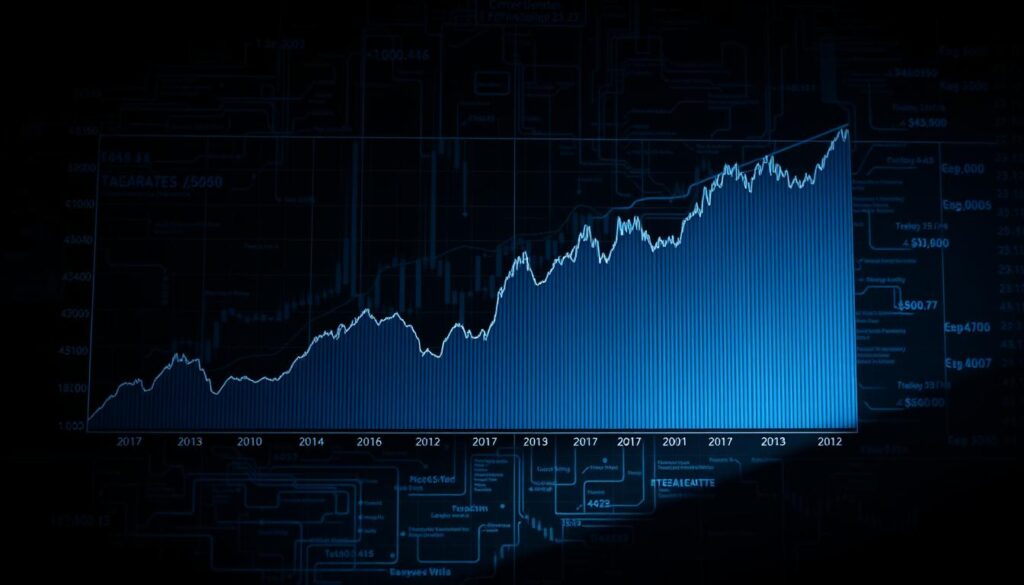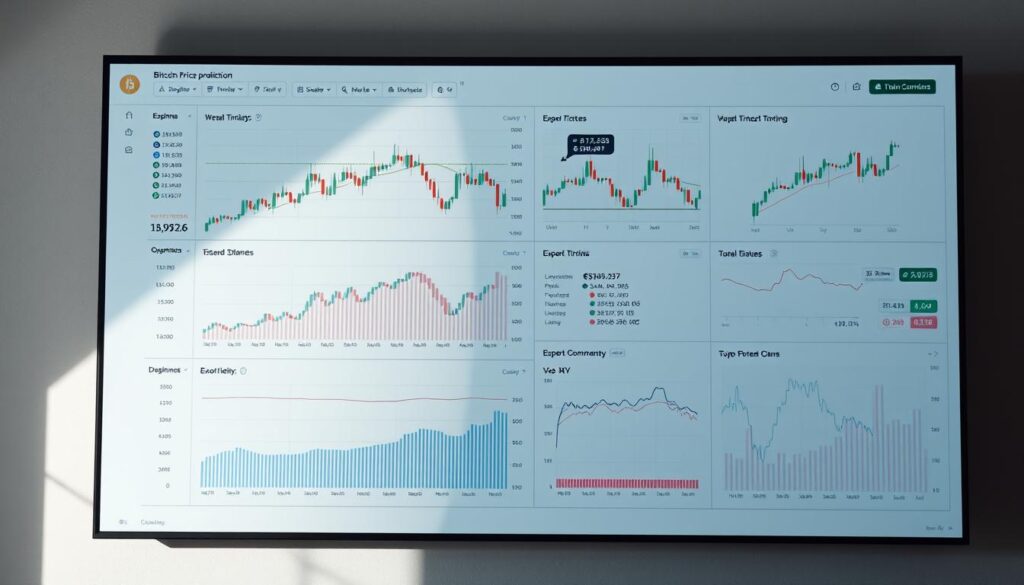Now Reading: BTC Price Prediction Next Month: Expert Forecast
- 01
BTC Price Prediction Next Month: Expert Forecast
BTC Price Prediction Next Month: Expert Forecast

This guide offers a detailed look at the bitcoin price outlook. We focus on expert analysis for the coming weeks. The current price is a key starting point for understanding potential moves.
Right now, the digital asset trades near $111,254 USD. This level represents a significant moment for the market. Activity today sets the stage for future movement.
Recent market data shows interesting trends. Volatility has been moderate. There have been more positive days than negative ones recently. This suggests underlying strength.
Our BTC price prediction for the next month combines several factors. We use technical charts and sentiment indicators. This helps create a clear forecast for traders and investors.
Introduction to Bitcoin’s Market Trends
The cryptocurrency landscape is dominated by Bitcoin, whose market movements set the tone for the entire sector. Its massive market capitalization of over $2.2 trillion underscores its leading role. This digital asset remains the most recognized and widely traded on any major exchange.
Recent activity shows strong positive momentum. Over the past week, the cryptocurrency has seen a significant upward trend. This recent price history indicates renewed investor confidence.
| Time Period | Performance | Significance |
|---|---|---|
| Last 24 Hours | +$1,533.44 | Short-term buying pressure |
| Last 7 Days | +5.66% | Sustained positive trend |
| Circulating Supply | ~19.94 million BTC | 95% of total supply issued |
These trends are influenced by many factors. Macroeconomic conditions and regulatory news play a huge part. Institutional adoption also continues to grow, integrating crypto into traditional finance.
For a deeper dive into these dynamics, consider understanding crypto market trends in more detail. This foundational knowledge is key for evaluating any short-term forecast.
BTC Price Prediction Next Month – Expert Insights
Analytical models suggest a favorable outlook for the coming weeks in cryptocurrency trading. Specialists combine technical charts with sentiment indicators to create comprehensive forecasts.
Current projections indicate potential growth through October. The digital asset could reach approximately $119,506 by late October, representing significant upward movement.
| Time Frame | Minimum Estimate | Maximum Potential | Average Projection |
|---|---|---|---|
| October 2025 | $111,622.06 | $125,444.50 | $118,533.28 |
| November 2025 | $114,727.97 | $123,706.41 | $119,217.19 |
Short-term analysis shows gradual appreciation beginning tomorrow. This establishes positive momentum that could extend through the entire period.
Market experts incorporate multiple frameworks in their assessment. These include historical patterns and macroeconomic factors affecting digital asset valuations.
While forecasts provide valuable guidance, cryptocurrency markets remain volatile. Unforeseen events or regulatory changes may impact actual results.
Understanding Technical Indicators
Three primary technical tools provide critical insights into cryptocurrency market dynamics and trend direction. These mathematical indicators help traders interpret complex market data and identify potential turning points.
RSI, EMA, and Bollinger Bands Overview
The Relative Strength Index (RSI) measures momentum on a scale from 0 to 100. Current conditions show a 14-day RSI at 51.65, indicating neutral territory. This suggests the asset is neither overbought nor oversold.
Exponential Moving Averages (EMA) track trend direction across different timeframes. The 20-period EMA at $111,718 acts as immediate dynamic support. Longer-term trends are visible through the 200-period EMA at $108,175.
Bollinger Bands create a volatility range around price action. The upper band at $122,056 represents potential resistance, while the lower band at $102,494 indicates support during volatile periods.
Identifying Support and Resistance Levels
Technical analysis relies heavily on identifying key price levels. The current trading range sits between $108,143 (support) and $111,909 (resistance). Breaking these levels signals potential directional moves.
Market sentiment becomes clearer when price approaches these critical zones. Subsequent resistance levels at $114,790 and $117,355 represent areas where traders might take profits.
| Indicator | Current Value | Signal | Timeframe |
|---|---|---|---|
| RSI | 51.65 | Neutral | 14-day |
| EMA 20 | $111,718 | Dynamic Support | Short-term |
| EMA 200 | $108,175 | Trend Direction | Long-term |
| Bollinger Upper | $122,056 | Resistance | Current |
| Bollinger Lower | $102,494 | Support | Current |
This comprehensive chart analysis helps traders make informed decisions. Understanding these indicators provides a solid foundation for assessing market direction.
Historical Price Analysis of BTC
Bitcoin’s historical price patterns reveal fascinating cycles that repeat over time. These cycles help investors understand potential future movements. The digital asset’s journey shows remarkable consistency despite market fluctuations.
Recent activity includes reaching $124,434 just 19 days ago. Current levels represent a normal 10.26% pullback from that peak. This correction falls within typical consolidation ranges.

Review of Price History and Volatility
October stands out as the strongest month historically. Data shows prices ending higher than they started in 10 out of 13 years. This 77% success rate makes October particularly significant for traders.
The cryptocurrency has experienced four major bull runs since inception. Each cycle followed a similar pattern of rapid growth followed by correction. The first major peak occurred in November 2013 at $1,156.
That initial surge was followed by an 81.7% decline over 413 days. This extreme volatility characterized early market behavior. Current 30-day volatility measures 4.85%, showing market maturation.
Cycles typically span approximately four years between new highs. This pattern correlates with Bitcoin’s halving events. The minimum recorded cycle length is 1,405 days.
For detailed current charts and analysis, visit the BTCUSD trading pair on TradingView. This historical context helps evaluate current positioning and potential scenarios.
Monthly Forecast and Trend Analysis
Daily projections for late October outline a clear path of appreciation. The forecast begins on October 25th and shows progressive gains.
This detailed look helps investors identify optimal entry and exit points. Specific dates provide clear targets for strategic decisions.
Short-Term Price Movements and Patterns
Momentum is expected to build significantly towards the month’s end. The maximum potential is projected for October 29th.
A slight consolidation follows this peak, indicating natural profit-taking. This pattern is common after strong upward moves.
The average for the period suggests a healthy upward trend. Steady weekly gains compound over time.
Key Forecast Dates and ROI Projections
Several dates stand out for their projected movement. October 27th and 28th are critical for testing new highs.
Investors can expect substantial returns based on these models. The potential ROI for October is compelling.
| Date | Projected Value | Daily Change |
|---|---|---|
| October 25 | $111,622.06 | +0.33% |
| October 26 | $115,036.28 | +3.4% |
| October 27 | $119,506.07 | +7.42% |
| October 28 | $123,571.18 | +11.07% |
| October 29 | $125,444.50 | +12.76% |
| October 30 | $124,016.18 | +11.47% |
| October 31 | $121,720.34 | +9.41% |
This data confirms a strong second half of October. The minimum support levels provide a safety net for the trend.
November’s outlook indicates continued strength. The pattern analysis combines technical and historical factors for a robust prediction.
Long-Term BTC Price Prediction Models
Multi-year projection frameworks analyze Bitcoin’s long-term growth potential beyond immediate market cycles. These comprehensive models incorporate various analytical approaches to forecast digital asset performance.

Projections for 2025 and Beyond
The price prediction 2025 framework suggests significant appreciation potential. Models project a maximum target near $221,485 by year’s end, representing substantial growth from current levels.
December 2025 forecasts indicate consolidation between $113,245 and $120,549. This suggests stability following earlier bullish movements throughout the year.
Looking further ahead, the 2030 bitcoin price prediction reaches approximately $369,701. This represents a 3.31-fold increase from current valuation levels.
Ultra-long-term models project even more ambitious targets for 2040. These predictions approach $1,018,422 based on continued adoption trends.
Analysts use multiple methodologies including stock-to-flow analysis and network metrics. These approaches help create robust forecasts for coming years.
Comparative Analysis with Traditional Markets
Evaluating Bitcoin as an emerging asset class involves contrasting its potential against both high-growth and declining traditional markets. This comparative market analysis provides a realistic framework for investment decisions.
If the digital coin follows the adoption curve of major tech firms, its valuation could soar. Projections based on market capitalization growth show varied potential for the bitcoin price.
| Comparative Model | 2026 Projection | 2030 Projection |
|---|---|---|
| Facebook Growth | $156,966.99 | $611,955.87 |
| Amazon Trajectory | $233,083.29 | $4,418,086.32 |
| Apple Steady Growth | $158,447.85 | $641,372.36 |
| Tesla Expansion | $253,231.32 | $6,687,527.48 |
These models illustrate a spectrum of possible outcomes. The asset could achieve valuations comparable to today’s largest corporations.
However, the analysis also includes cautionary tales. If Bitcoin faces disruption like legacy tech, prices could fall significantly. Models based on Kodak and Nokia suggest potential declines to $83,768 and $74,001 by 2026.
This comparative approach helps investors view the bitcoin price not in isolation, but within the broader market landscape. It underscores that the ultimate investment return depends on which path—growth or decline—the market ultimately follows.
Methodologies Behind BTC Price Forecasts
Creating reliable financial forecasts for digital currencies demands systematic approaches to data interpretation and trend identification. Multiple analytical frameworks combine to form comprehensive bitcoin price prediction models that assess various market dimensions.
Trend Analysis and Data Modeling Techniques
Technical analysis currently reveals mixed signals with 4 buy indicators versus 9 sell signals. This creates a short-term bearish prediction sentiment based on current market metrics.
On-chain analysis examines Bitcoin protocol information including transaction volumes and miner behavior. This approach identifies potential catalysts not visible in traditional chart data.

Comparative modeling studies technology adoption curves and digital asset maturation patterns. These techniques help project long-term appreciation scenarios for accurate forecast development.
Quantitative models incorporate macroeconomic factors like inflation rates and institutional flows. This contextualizes each bitcoin price prediction within broader financial conditions.
The synthesis of these methodologies produces more robust prediction outcomes than any single approach. Consensus forecast models emerge from converging technical, fundamental, and quantitative data techniques.
Expert Forecast Data for 2025
Two distinct scenarios emerge from expert analysis of the cryptocurrency’s potential trajectory next year. Financial specialists have developed comprehensive models projecting performance throughout 2025.
These frameworks incorporate technical indicators, market sentiment, and macroeconomic factors. The resulting predictions provide valuable guidance for strategic planning.
Minimum, Maximum, and Average Price Predictions
The conservative price prediction 2025 establishes a modest growth outlook. This model projects a maximum value around $123,233.58 USD by year’s end.
The conservative average trading level sits at $118,216.05 USD. This suggests relatively stable market conditions throughout the year.
Monthly breakdowns show a gradual decline from January to December. The conservative prediction 2025 indicates potential correction following previous market peaks.
An alternative aggressive price prediction 2025 presents much higher targets. This model anticipates a maximum reaching $221,485 USD.
The aggressive scenario supports an average trading value significantly above current levels. This prediction 2025 accounts for continued institutional adoption and network growth.
Both models establish important support levels for investors. The conservative minimum provides a safety net during market corrections.
Implications of Current Market Conditions
Current market conditions reveal a complex interplay between investor sentiment and Bitcoin’s fundamental strength. The Fear & Greed Index sits at 30, indicating fear dominates trader psychology despite relatively stable performance.
The digital asset’s current price of $111,254 USD represents a 10.26% correction from recent highs. Technical indicators show only 42% bullish sentiment, suggesting cautious positioning among market participants.

BTC has demonstrated resilience with 57% green days over the past month. This performance occurs within a moderate 4.85% volatility environment. The market capitalization remains strong at $2.215 trillion USD.
These conditions suggest a transitional phase for the digital coin. Fear-driven selling meets underlying buyer support. This creates consolidation patterns that often precede significant BTC movements in either direction.
Understanding these dynamics provides crucial context for short-term forecasts. Market metrics help assess the probability of various scenarios materializing in coming weeks.
Analyzing Crypto Market Sentiment
Market sentiment analysis reveals a fascinating tension between immediate technical signals and broader trend patterns. This divergence creates unique opportunities for informed investors who understand different timeframes.
Short-term indicators currently show cautious sentiment with only 42% bullish signals. The Fear & Greed Index sits at 30, reflecting trader nervousness. Meanwhile, long-term trends tell a different story.
Short-Term vs Long-Term Trend Dynamics
The 200-day moving average has been rising since April 2025, indicating sustained upward momentum. Weekly RSI at 63.48 shows healthy strength without overbought conditions. This contrast defines current market dynamics.
Four-hour and daily charts maintain bullish structures with rising moving averages. Historical data supports October as statistically strong—positive in 10 of 13 years. This 77% success rate reinforces positive trend expectations.
| Timeframe | Sentiment Indicator | Current Reading | Market Implication |
|---|---|---|---|
| Short-Term | Bullish Signal Percentage | 42% | Cautious Trading |
| Medium-Term | Weekly RSI | 63.48 | Healthy Momentum |
| Long-Term | 200-Day MA Direction | Rising Since April | Sustained Uptrend |
| Historical | October Performance | 77% Positive | Seasonal Strength |
Professional investors maintain bullish positioning based on network fundamentals. Retail sentiment reflects fear, which historically precedes upward movements. Understanding these dynamics helps navigate crypto volatility effectively.
Price Prediction and Investment Strategies
Investors seeking to capitalize on digital currency opportunities must develop disciplined strategies. October’s 13.3% potential return suggests favorable short-term positioning at current levels.
The bitcoin price structure offers multiple entry points. Aggressive traders can target breakouts above $111,909 resistance. Conservative investors may prefer accumulation near $108,143 support.
Dollar-cost averaging remains effective for long-term accumulation. This approach uses consistent entry points rather than perfect market timing. The limited supply of 19,939,100 coins supports scarcity-based investment.
Portfolio allocation should treat this asset as high-volatility. Most advisors recommend 1-5% weights for conservative investors. Those with higher risk tolerance might allocate 10-20%.
Risk management requires clear stop-loss levels below support. Profit-taking targets should align with resistance zones at $114,790 and $117,355. Choose reputable exchange platforms for trading security.
This comprehensive price prediction framework helps shape sound investment decisions. The btc price outlook combines technical analysis with practical strategy implementation.
Future Forecast Review and Data Insights
Future forecasting combines near-term analysis with decade-long projections for complete perspective. This approach provides comprehensive data insights for investors with different time horizons.
The bitcoin price prediction framework shows non-linear progression through 2030. Models project significant growth with occasional correction years. This pattern reflects typical four-year cycles.
Supply dynamics provide fundamental support for long-term forecasts. Only 1,060,900 coins remain to be mined over the next century. This scarcity impacts valuation models.
| Year | Maximum Projection | Cycle Pattern |
|---|---|---|
| 2026 | $195,067 | Growth Phase |
| 2027 | $124,483 | Correction Year |
| 2028 | $255,199 | Resumed Growth |
| 2029 | $419,768 | Bull Market |
| 2030 | $369,701 | Consolidation |
Historical data reveals consistent patterns between market peaks. The 1,405-1,477 day cycle corresponds with halving events. These reduce new supply issuance.
Near-term analysis shows gradual appreciation through month’s end. Daily gains support the overall positive outlook. This forecast combines multiple analytical approaches.
Conclusion
As we conclude this examination of market dynamics, the convergence of technical and fundamental factors suggests optimistic prospects. Expert analysis indicates strong potential for appreciation, with forecasts projecting significant opportunities for strategic investors.
The outlook balances short-term technical signals with longer-term bullish trends. This supports continued strength despite current market sentiment showing some fear among traders.
Investors should recognize that while forecasts provide valuable guidance, cryptocurrency markets remain inherently volatile. Actual movements may deviate based on unforeseen regulatory or macroeconomic developments.
At this time, conditions favor patient accumulation strategies rather than aggressive trading. The limited supply of Bitcoin coins provides fundamental support for positive projections throughout the coming year.
While short-term volatility may produce temporary price drop scenarios, the convergence of indicators supports upward movement. This comprehensive prediction framework helps shape sound investment decisions in the cryptocurrency space.















